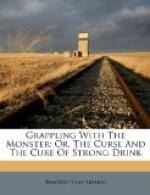If the reader will refer to the quotation made by us in the second chapter from Dr. Henry Monroe, where the food value of any article is treated of, he will see it stated that “every kind of substance employed by man as food consists of sugar, starch, oil and glutinous matter, mingled together in various proportions; these are designed for the support of the animal frame. The glutinous principles of food—fibrine, albumen and casein—are employed to build up the structure; while the oil, starch and sugar are chiefly used to generate heat in the body.”
Now, it is clear, that if alcohol is a food, it will be found to contain one or more of these substances. There must be in it either the nitrogenous elements found chiefly in meats, eggs, milk, vegetables and seeds, out of which animal tissue is built and waste repaired; or the carbonaceous elements found in fat, starch and sugar, in the consumption of which heat and force are evolved.
“The distinctness of these groups of foods,” says Dr. Hunt, “and their relations to the tissue-producing and heat-evolving capacities of man, are so definite and so confirmed by experiments on animals and by manifold tests of scientific, physiological and clinical experience, that no attempt to discard the classification has prevailed. To draw so straight a line of demarcation as to limit the one entirely to tissue or cell production, and the other to heat and force production through ordinary combustion, and to deny any power of interchangeability under special demands or amid defective supply of one variety, is, indeed, untenable. This does not in the least invalidate the fact that we are able to use these as ascertained landmarks.”
How these substances, when taken into the body, are assimilated, and how they generate force, are well known to the chemist and physiologist, who is able, in the light of well-ascertained laws, to determine whether alcohol does or does not possess a food value. For years, the ablest men in the medical profession have given this subject the most careful study, and have subjected alcohol to every known test and experiment, and the result is that it has been, by common consent, excluded from the class of tissue-building foods. “We have never,” says Dr. Hunt, “seen but a single suggestion that it could so act, and this a promiscuous guess. One writer (Hammond) thinks it possible that it may ‘somehow’ enter into combination with the products of decay in tissues, and ’under certain circumstances might yield their nitrogen to the construction of new tissues.’ No parallel in organic chemistry, nor any evidence in animal chemistry, can be found to surround this guess with the areola of a possible hypothesis.”




